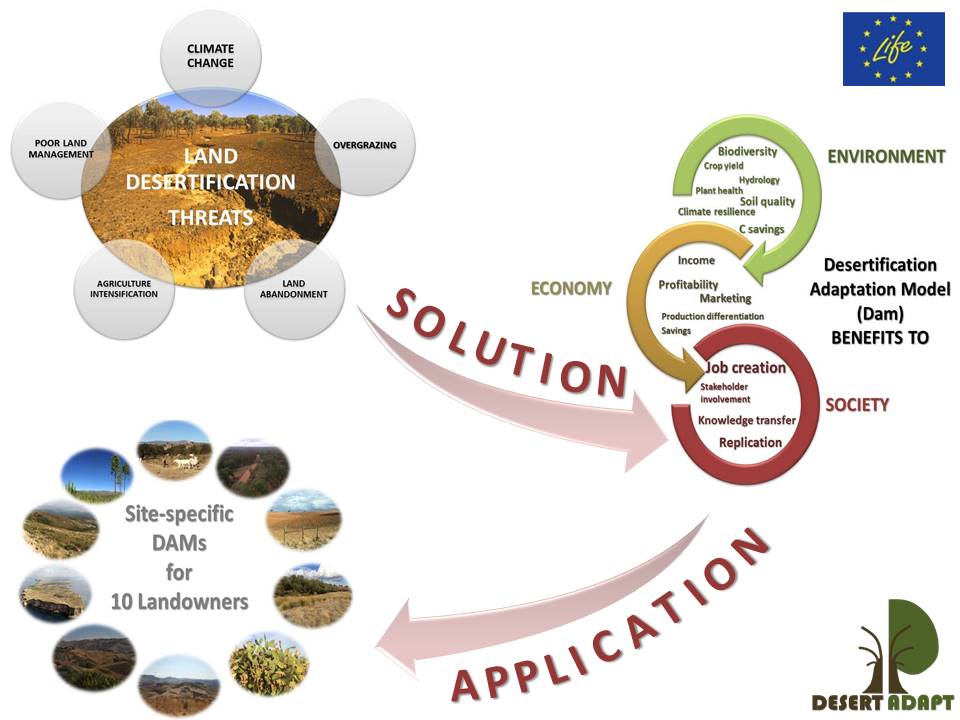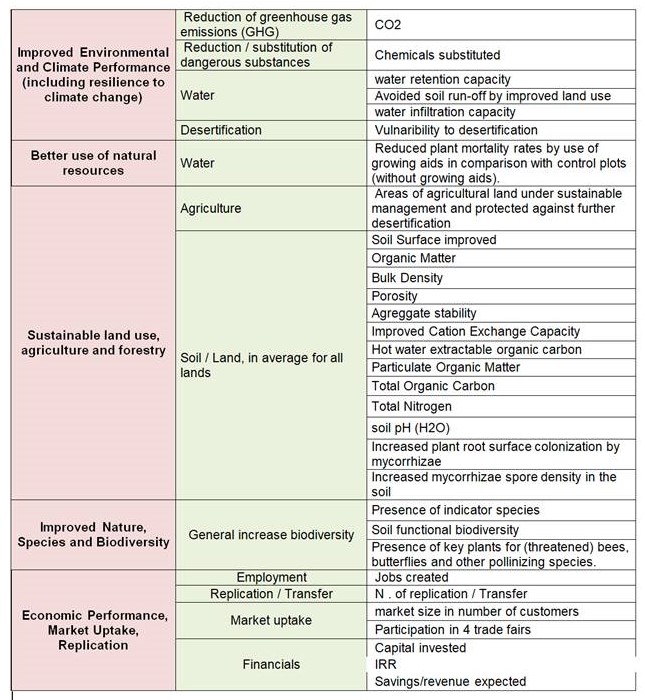
|
|
Project n°: LIFE16 CCA/IT/000011 Location: Portugal/Spain/Italy Duration: start: 01/09/2017 - end: 01/09/2022 extended to 01/09/2023 Budget: total amount: 4,075,040 euro, % EC co-funding: 2,439,761 euro Priority area: Climate Change Adaptation (CCA)
Climate Change Climate change is considered globally as one of the greatest challenges humanity is facing today. The European Union LIFE program has a component dedicated specifically to climate actions. This sub-program, LIFE+ Climate Action, co-finances projects that help to develop and demonstrate effective technologies, tools and methodologies that meet EU climate and environmental policy targets. Adaptation and Mitigation The project Desert-Adapt is developed under the LIFE+ Climate Action sub-program, Adaptation climate priority. Adaptation to climate change is of particular importance for the Mediterranean region which is experiencing increasingly negative climate change effects such as drought and extreme temperature more than other areas in Europe. The project will focus on Adaptation measures aimed at reverting ongoing desertification trends and building more climate resilient local communities. Additionally, it will also address the policy priority of Mitigation, by restoring vegetation cover and soil organic content, resulting in net removals of CO2 from the atmosphere.
The Main Goal of Desert-Adapt is to demonstrate innovative climate adaption strategies and technologies to improve land quality, soil conservation and plant support for private and public lands in Mediterranean areas under desertification risk The two key objectives of the project are: 1) Demonstrating the effectiveness of innovative adaptation technologies, to improve socioeconomic development and environmental quality in 3 E.U. regions already affected by climate change, by appling Desertification Adaptation Models - DAM (framework of approaches) tailored to site-specific conditions and opportunities. 2) Promoting and replicating the developed DAM frameworks among a variety of stakeholders, particularly local farmers seeking socioeconomic opportunities from climate resilient and profitable land use and policy makers, to help enable replication and upscaling in the project regions and beyond. The "Desertification Adaptation Models (DAM)" are specifically designed to counter aridification and subsequent land desertification. An overall integrative ecosystem approach is taken, to ensure that climate change adaptation targets are combined with improved ecosystem functions (e.g. carbon sequestration, water retention, biodiversity) and improved socioeconomic development. The project is expected to benefit local farmers in particular, with income opportunities from new combinations of products and ecosystem services and through cooperatively organized promotion, sales and marketing. Also, local biodiversity is to benefit, through more structural complexity of vegetation, increased pollinator attraction and reduced impacts on soil and environment. Other outcomes include developed capacity to prepare farmers for various certifications. 1st main expected outcome of the project is "10 established Desertification Adaptation Models (DAM)". More specifically, results are: 1. Established Desertification Adaptation Model on 1000 hectares of land in Italy, Spain and Portugal, 2. Safeguarding and Improvement of Biodiversity and soil quality, including a 50% increase in soil functional biodiversity; at least 10% improved presence of indicator species, significant improvement in soil quality and reduction of soil loss and erosion. 3. Improved socioeconomic benefits, with at least 8 viable income sources selected; a 100 Euro per hectare (or 100%) farmer income increase; an employment increase to 0,1 FTE per hectare and an overall IRR improvement to at least 6%. 4. Climate Change Mitigation results include a net carbon removal of 1 ton CO2-e per hectare. 2nd main expected outcome is "successful replication and upscaling with maximized adoption of adaptation technologies". Results include: 1. Self-supporting company for collective purchase, sales, marketing and farmer-promotion: 2. Ten project partners trained as promoters, each successful in knowledge transfer to 10 more farmers (100 farmers and 10.000 hectares in total after the project). 3. At least 30 cooperation agreements signedwith commercial partners for products and eco-services and DAM products promoted at 4 trade fairs.
Overall view of project actions and action timeline get PDF For a detailed role of each partner in each subaction get PDF To stop further marginalization of the demonstration areas, an integrated ecosystems approach is proposed by this project based on two key aspects: A) the adoption of an Integrative Soil & Land Use Management B) The development of climate change-resilient and taylored land use systems.
INDICATORS OF PROJECT PERFORMANCE In order to evaluate the effectiveness of the project in delivering the expected outcomes the project has set a group of indicators of performance. These will be analysed at the beginning of the project to assess the baseline, i.e. the state of such indicators in the present conditions of management of the lands included in the proejct, and after five years, at the end of the project, to verify their status after land management implementation. The indicators cover several aspects, spanning from indicators of environmental quality to social and economic indicators. This reflects the nature of the project, which aims at improving the ecosystem services in the study areas by choosing at the same time options which are economically sustainable, so to stimulate partner and landowners to continue the implementation after the project and new landowners to join in. The indicators which will be used in the project are reported in the following table.
PROJECT CONTRIBUTION TO EU POLICY PRIORITIES The project also contributes to the Priority Area "Climate Change Mitigation", as it focuses on Land-use, Land-use change and Forestry (LULUCF). The project develops practical methods and tools for establishment, replication and upscaling of integrated land use management. Applied methods aim at enhancing terrestrial carbon sinks and optimize net GHG removals, making important contributions to the Paris Climate Agreement, even more so by focusing on marginalized land areas unfit for current and future food production. Offering alternatives to soil degradation is key aspect of this project, as well as the increase of soil organic content. As to specific EU policy priorities focused on, the project contributes to the Land use sector, by promoting new concepts and economic activities for improved land use to enhance land based carbon sinks and to help curb current desertification trends and related GHG emission. And by developing short supply chains for sustainably produced products, overall consumption patterns become more climate friendly. With regards to Greenhouse gas accounting, project contributions include carbon data collection from a variety of contexts in three countries and carbon certification methodologies involving (groups of) landowners of different types and sizes. Policy contributions to agriculture are two-fold; implementation of low-emission farming practices with a strong transformational impact and offering new greening approaches for policy frameworks, particularly the Common Agricultural Policy (CAP).
|






